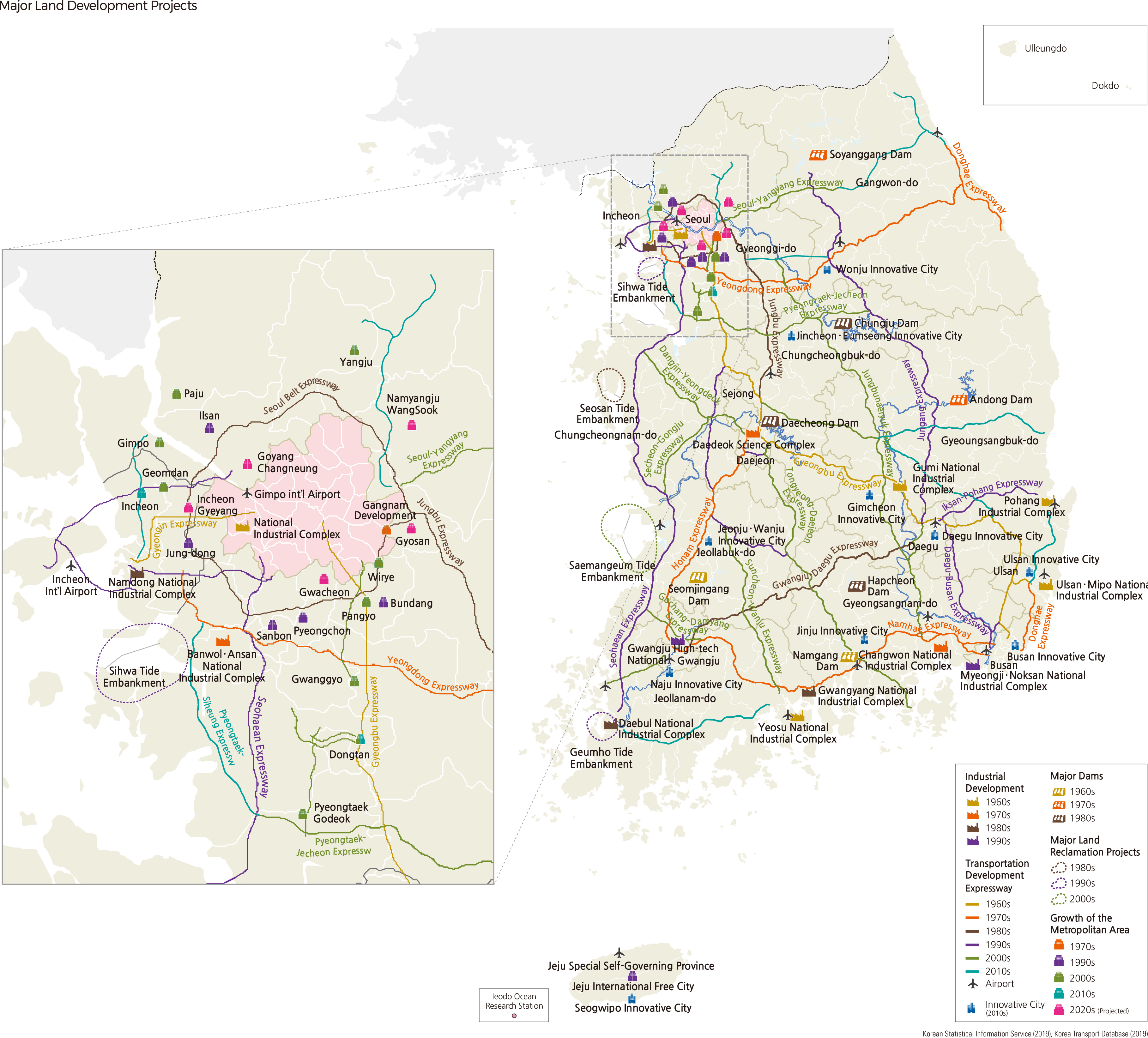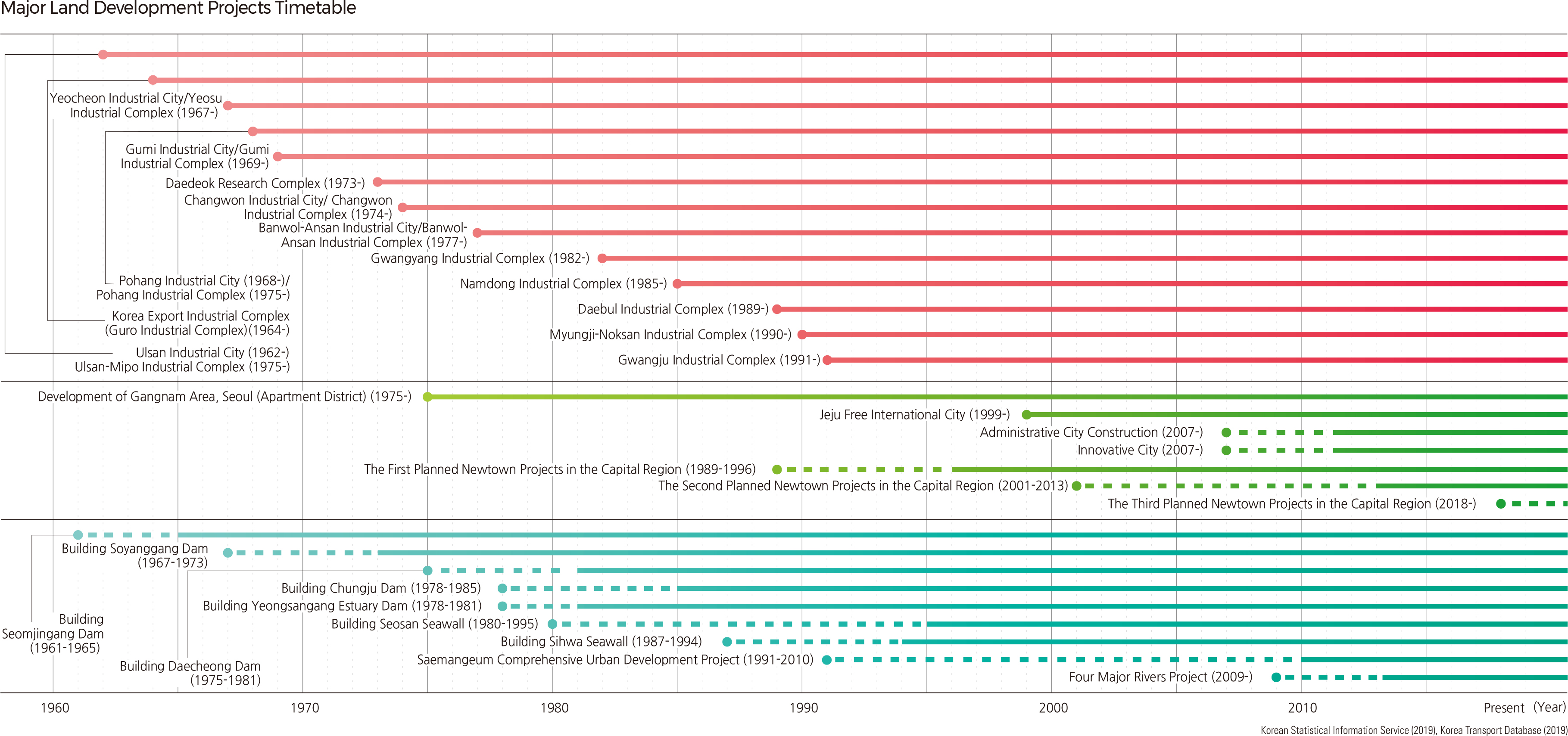English I 2019
Historically, the Korean Peninsula has been called Geum-sugangsan, which can best be translated into this poetic phrase: nature appearing as if it were embroidered on silk. Unfortunately, years of Japanese occupation and the subsequent Korean War divided the country into North Korea and South Korea and devastated the nation’s infrastructure, industrial capability, and housing. This devastation led to a shortage of natural resources such as minerals, lumber, oil, and gas, triggering a collapse of the national economy, especially in South Korea. Until the early 1960s, Korea was forced to focus on recovering from the devastation of war by utilizing international aid to restore public facilities and rebuild the national economy. For the last 60 years, there have been many changes in the Korean landscape, most of which have stemmed from government-led land development projects, urbanization, and industrialization.
In the early 1960s, the government’s master plan for land development was put into action. The government based its plan on the growth pole theory in order to quickly develop the nation. Though well-intentioned, the growth pole approach only allowed for investment in the few central development areas that were most likely to succeed before development could be considered in other areas. Unfortunately, this approach resulted in both people and capital flowing to those few development centers. The resulting imbalance between those centers and the rest of the country was later corrected with the implementation of a more balanced set of development policies.
Under the Special Area Development Project, Seoul, Incheon, and Ulsan were selected as Special Areas to be developed first on the premise that the effects of such development would gradually envelope the surroundings areas. The Industrial Park Development Project began in Ulsan and Seoul in the early 1960s. Also, during the 1960s and 1970s, the Industrial City Construction Project was launched at targeted sites near such industrial parks. It led to the emergence of major chemical industries concentrated in cities such as Ulsan-si, Yeocheon-si, Pohang-si, and Gumi-si, with a concordant rise in population in each of these cities.
Since the 1960s, the South Korean government has fostered economic growth through export by building industrial complexes and new cities. Beginning with the Ulsan Industrial Complex, which was completed in 1962, and the Korea Export Industrial Complex (Guro Industrial Complex) in 1964, many industrial complexes and their adjacent cities emerged in and around Yeocheon, Pohang, Gumi, Incheon, Changwon, Banwol (Ansan), and elsewhere from the late 1960s through the 1970s.
Other major development projects from the 1970s to the present include a number of natural resource and energy-related projects such as reforestation, land reclamation, multipurpose dam construction, and nuclear power plant construction. In 1965, multi-purpose Seomjingang Dam was built across the Seomjin River. More multi-purpose dams were built straight through the 1970s to the 1980s; the Soyanggang Dam, Daecheong Dam, and Chungju Dam are notable examples. All possess hydroelectric power generation capabilities. In 1978, Korea’s first nuclear power plant, the Gori Nuclear Power Plant No. 1, was built and began operating near Busan. Subsequently, more nuclear plants were built in Wolseong, Uljin, and Yeonggwang.
Urbanization has had significant impact on the country's demographics, its physical landscape, its social-behavioral institutions, and its economy. As the number of cities increased, the population of rural areas declined, which also led to a decrease in the percentage of the population that was engaged in agriculture and fishery activities.
The emergence of metropolitan centers is a major feature of development in Korea and resulted primarily from the rural-to-urban migrations, especially in the capital. After the 1960s, rapid urbanization and industrialization attracted secondary and tertiary industries to cities as well. More jobs were created, prompting further mass migrations from rural to urban areas. The urbanization rate, which indicates the ratio of urban population as a percentage of the total population, increased rapidly in Korea until the 1980s, but the pace has slowed since then. Between the 1970s and 1980s, urbanization occurred at a much faster rate than in many other countries. As a result, rural areas suffered from the lack of a labor force, a decrease in the coefficient of land utilization, and the rapid aging of its population; these factors ultimately contributed to the failure to meet the minimum requirements for sustaining a rural community in many instances. At the same time, urban areas were confronted with the need to mitigate the challenges of overcrowding. The heavy concentration of industrial activity within the metropolitan areas resulted in serious social and environmental issues such as housing shortages, traffic congestion, poor air quality, and overall environmental degradation.
There was a clear trend toward excessive expansion in both the capital area and the port cities surrounding the Southeastern Maritime Industrial Region. The expansion between these two regions is mainly related to the industrialization that took place along the Gyeongbu Axis. Seoul experienced excessive increases in population, but this trend has stalled and decreased since the 1990s. The population of nearby satellite cities, however, keeps growing, which results in a population concentration in the greater metropolitan area with Seoul at its center.
Since 2000, various projects for balanced national development have been carried out. As a result, in 2012, Sejong Special Self-Governing City was launched and a new administrative town was constructed. In addition, Innovation Cities were created in non-capital areas along with the relocation of public agencies to provincial areas. |

